The Best of Bay Weekly 2006
We want every story we write at Bay Weekly to be our best. But it’s only in retrospect we see — always with startling clarity — subject and telling so aligned as to lift a story above the weekly grind, into star-spangled memory.
These are the stories we remember best from the pages of 52 issues of Bay Weekly in 2006. Under various headings — features, sports, business, arts and entertainment, environment, science, growth and development and education — they’ll be our entries in the Maryland-Delaware-District of Columbia Press Association’s editorial contest for 2006. In the new year, judges from the North Carolina state press association pick the top two stories from all the competing entries sent by papers in five size categories. Ours is nondailies with 10,000 to 20,000 circulation.
Will we win? Send your advice and mojo to [email protected] before January 11.
Arts/Entertainment

Cracking the Nutcracker Code
Why a 200-year-old fantasy is Christmas’s favorite ballet
by Carrie Madren
In cities throughout the United States, The Nutcracker is holiday tradition at its invariable best. Houses are packed as Maryland dancing schools and companies dance nearly a dozen unique Maryland productions.
The rest of the year, the old art of ballet competes with movies, musicians, theater, musical theater, circuses, comedians and all sorts of live performances. During the holidays, ballet takes the limelight, using the wordless language of dance to tell a two-century-old story.
Tradition, artistry, the excitement of a good story and the pull of money combine each December to open Nutcracker’s mysterious portal into another Christmas world.
–No. 49: December 7
Feature
Where Have All the Chessies Gone?
by Kat Bennett
Bay lore tells of a time when every one of the 26,000 families of the Eastern Shore owned at least one Chesapeake Bay retriever. Maryland governor Edward Lloyd thought so highly of the breed he sent a Baltimore clipper just to fetch one. In 1964, the Chesapeake retriever was legislatively proclaimed the official state dog of Maryland.
Yet today the Bay’s own dog is considered a rare breed. Fewer than 1,300 were registered in the entire United States in 2004.
Perhaps the Chesapeake retriever is too stubborn and independent for modern tastes. Perhaps the dog is too big or too smelly. Or perhaps these retrievers no longer have the skills they once had. The answer is more complex. The decline of the dynasty must be tracked through three entwined stories: one about the ducking dogs of the Chesapeake; another about the Bay itself; and a third about the people of the Bay and how they’ve changed.
—No. 9: March 2
Vera’s Last Act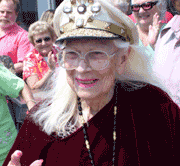
by Sandra Olivetti Martin
If Vera Freeman had been in the movies, she couldn’t have acted her way to a better-scripted ending.
But on this June afternoon in 2006, as the sun gilds Leonard’s Creek with a glory that pinches your heart, Vera is watching the end of the dream the aspiring girl from Montana deferred when Dr. Freeman, optometrist to the stars, proposed to her half a century ago.
Instead of Hollywood, Vera made her home in Calvert County.
After all these years, on the White Sands Road exit from Route 2-4, the sign is down, and Vera’s ageless, exotic effigy no longer beckons. Vera’s White Sands has been gutted and her signature pink painted over. This weekend, Vera’s White Sands Beach Club reopens, recast by neighbors Steve Stanley and Lisa Del Rico.
Pale — sunlight seems never to have touched her skin — and bemused, Vera comes as guest to her former domain, the Patuxent River promontory she colonized as a bit of Polynesia.
—No. 24: June 22
Rocked in the Cradle of Invasion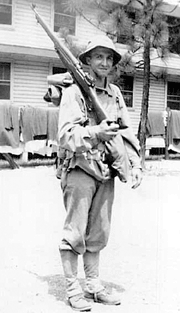
by Russ Barns
Sometimes understanding dawns on you in unexpected, synchronous places. At Calvert Marine Museum in Solomons, a series of insights illuminated my past, my present, my future, my country — and my father.
Across Back Creek, Doug Alves, the museum’s executive director, pointed toward the Dowell Peninsula. “There’s an old Chesapeake amphibious training base there,” he said, “where U.S. Marines and army soldiers prepared for amphibious invasions in the European and Pacific theaters of military operation during World War II.”
That long-ago invasion became the first Allied incursion into the Nazi- and Fascist- dominated European continent.
The person carrying half my DNA, my father, had, right here, likely climbed over the side and waded in the wet sand to the beach.
Here, in 1942, my father trained — just before my conception at Fort Bragg, North Carolina — for his World War II career in Europe. The simulated training off Solomons prepared him for hitting the beaches during the Invasion of Sicily.
My dad, Clayton Junior Barnes — nicknamed Barney — kept documenting his daily grand tour of Europe from Sicily to Munich. Immediate, direct and factual, the diary is recorded from the perspective of a foot soldier. Discovered by my brother at our father’s death in 1991 and since preserved in digital format, it provides a rare eyewitness and primary documentation of the war.
—No. 31: Aug. 3
Hip to be Square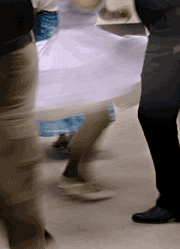
You Can’t Not Have Fun Square Dancing.
by Danita Boonchaisri
I was clear from the very beginning; I did not come to dance. I had done the obligatory cavorting in fifth grade as part of the school system’s ruse to encourage appropriate boy/girl interaction, and I was still vaguely familiar with the basic do-si-do and promenade. But my square dancing days were more than 30 years behind me, and I had no intention of reliving them this Friday night.
I had come simply for the intrigue; beckoned by the two words that completed a short paragraph in Calvert County’s Parks & Recreation Guide: “Visitors welcome.” I wanted only to observe and satisfy my curiosity about what I thought certainly could not be true. Do people actually still square dance? And if so, why?
—No. 35: Aug. 31
Long Strides Toward a Cure
by Dotty Holcomb Doherty
Gasping briefly, I tie a wet cold bandana around my neck. I head out for a training walk under the steady buzz of cicada, preparing for the Chesapeake Bay MS Challenge Walk. I leave before the real heat of the day sets in, with its unbidden promise of 100 degrees, and find the nearest shade. I know the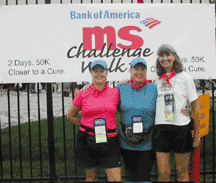 drill; I have done this before. drill; I have done this before.
I began challenge walking six years ago. I found myself able to raise the required $1,500 in pledges, and, having trained judicially, I felt I was ready. But I was not prepared for the emotions that would well up in me as we walked.
Then, in 2002, I was diagnosed with multiple sclerosis.
—No. 39: Sept. 28
Business/Economic
The Great Green Hope
by Matt Makowski
Maryland tobacco crashed this week.
A mere 300,000 pounds went to market in the famous Maryland tobacco auction, where farmers follow the auctioneer down the bales to hear their fortunes told by buyers. More than a million pounds sold in both 2005 and 2004. Over two million sold the year before. In 2002, over three and a half million. In 2001, over eight million. That’s the story of Maryland tobacco.
But Maryland tobacco may rise from the dead. Protein and ethanol wrung from tobacco’s green leaves may bring the one-time cash crop back to Maryland fields.
Tobacco advisor Gary Hodge, bio-entrepreneur Neil Belson, scientist Robert Kratochvil and congressman Steny Hoyer don’t believe tobacco has gone up in smoke. Proteins could redeem the stigmatized crop. Its broad leaves could fuel industry.
“It really is exciting when you think of the many benefits in the context of rural development, replacing petroleum and reducing greenhouse emissions,” Belson said.
—No. 12: March 23
Where the Three Little Pigs Went Wrong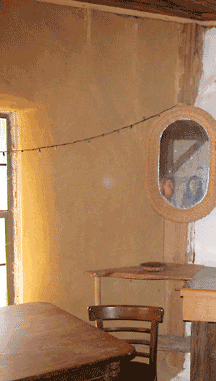
by Maureen Miller
Once upon a time, our ancestors found shelter in caves. As our species ventured out, homes were cleverly formed with whatever came to hand: mud, thatch, trees, clay and even ice blocks.
The most popular material choices for home building, with some variation, remain much the same as those used by the Three Little Pigs in Joseph Jacob’s 1890 classic: straw, sticks or bricks.
Jacob’s third little pig comes off as the smartest of the three. His brick house survives the fierce huff-and-puff test of the Big Bad Wolf. Additionally, this pig was intelligent enough to put in a fireplace, for when the wolf climbed down the chimney, he fell into a pot of boiling water. Voila: Wolf soup for dinner.
As strong as the little pig’s brick home with fireplace was in the face of danger, brick is not all that energy efficient, nor are fireplaces such as the pig’s.
You may be surprised at which pig’s home affords not only safety and comfort, but also future environmental sustainability.
—No. 15: April 13
Buy at Auction; Remodel at Leisure
by Allen Delaney
Two things in this world can hide ugly: liquor and vinyl siding. The latter caused me to part ways with thousands of dear Benjamin Franklins, all because of the blue vinyl siding that covered a little old cottage located two blocks from the boardwalk in North Beach, where I discovered the many ways a small house — and my dreams of prosperity as a landlord — could go wrong.
—No. 15: April 13
Measuring Business Success in More Than Profits
by Carrie Madren
Baker Caterina Borg hopes her cookie and cakes company, Mumsies, will support not only herself but also its charitable partner Sweet Missions, in giving to local, national and international causes. A 15- to 20-percent tithe from Mumsies’ sales will be funneled into charity through Sweet Missions.
In her freshman year of combining business and charity, Borg joins a long line of business owners who work for more than profit.
Barbara Sturgell, 20-year owner of Happy Harbor in Deale, does business on the same principle, without convening an advisory council.
Sturgell and Borg are two of countless businesspeople who make it their business to reach out to neighbors in need. Chesapeake Country abounds with businesses sponsoring Little League teams, collecting funds for breast cancer, hosting food drives or carving out their own ways to help meet a local or national need.
For all of them, charity is good business because it returns a share of goodwill.
—No. 47: Nov. 22
Education
At Chesapeake Bay Earth School, Chesapeake Bay — and Bay Weekly — Are Textbooks
by Ben Miller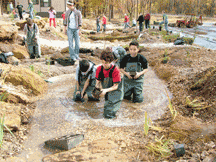
On a beautiful, mid-week spring day, six middle-school children boated on the West and Rhode rivers, walked in the woods and gazed at clouds.
No, the students didn’t cut class, Tom Sawyer style.
For Win Reilly, Sharif Mabie-Alkhaldi, Thea Grusky-Foley, Ravi Kumar, Sky Lawson and Isaiah Baden-Payne, the Chesapeake Bay Home Schooling Collaborative was in session.
The best education, says founder Romi Pittman, “grows out of the local community.” Thus the students of the Chesapeake Bay Home Schooling Collaborative explore big issues and subjects, learning through instruction and self-exploration and applying what they learn to understand the history, environment and community of the place where they live: Chesapeake Country.
—No 17: April 27
Environment
Shopping for Cleaner, Greener Wheels
by Carrie Madren
My guzzling Infiniti J30 burned a gallon and a half of gas getting me 36 miles to Catonsville, where I hoped to discover a cleaner, cheaper way to get around.
It was Alternative Fuels Day, and as I drove up Interstate 95 to one of the National Alternative Fuels Training Consortium’s Alternative Fuels showcase, at Baltimore County Community College, I daydreamed about pumping less gasoline into my car and less pollution into our air.
I’m just one 27-year-old person, but if I drove a fuel-efficient car for the rest of my life, I could prevent hundreds to thousands of pounds of air pollution, depending on which car choices I make in the next 74 years of my future. That’s assuming progeny let me behind the wheel at 100 years old.
—No. 46: Nov. 16
Growth and Development
Barn Razing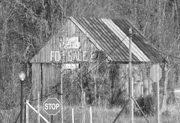
Will Maryland Tobacco Barns Go up in Smoke?
by Margaret Tearman
My husband and I are building a barn, an old-fashioned wood barn, not one of these new-fangled metal structures. We could have made do with an ordinary garage, but we wanted a barn. I was raised in Southern California where I could only fantasize about the country life. My husband comes from a long line of Indiana farmers, and a barn is an emotional connection to his family and to the land that supported so many generations of Tearmans.
We wish we owned an old barn, a genuine piece of the original Calvert County farmstead. The farmhouse survived, but the barns didn’t fare so well. This is true of many farms in Southern Maryland, as tobacco is replaced by other crops and fields are filled with subdivisions.
Throughout history, barns have brought communities together with barn raisings and barn dances. Today barns are bringing people together for a new reason: to save their barns.
—No. 3: Jan. 19
General News

Snatched!
The story behind the story of how Sinbad the Chihuahua escaped the talons of death
by Valerie Lester
Outside, something else was watching. The attack happened fast, the little dog’s teen-aged owner recalls:
“All of a sudden this huge thing swooped down and tried to pick him up in its talons. It had him for a moment, but dropped him, and Sinbad started rolling over and over and yelping, and the hawk caught him again, and I flung open the door, screaming Sinbad! and flapped my arms to make the hawk go away, but it wouldn’t let go. So I grabbed Sinbad’s rear end and tried to pull him away, but I fell back because the hawk was so strong. I knew it was hurting Sinbad. It was like a tug of war.
“I fell in the mud, and the hawk started off with Sinbad. But I got to my knees and grabbed him again and started swinging him from side to side. That’s why the hawk let go of him, I think.”
—No. 12: March 23
Sports Feature
Dangers at Sea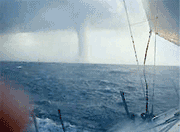
by Al McKegg
The risks of sailing the Chesapeake Bay can’t be compared to the Southern Ocean, where the sailors of the Volvo Ocean Race thrive on confrontation with the fiercest forces of nature.
But it’s also true that whenever and wherever you’re on the water, you’re exposed to risks beyond those on land.
We found that out firsthand in April, 2002, as the Volvo racers swept down Chesapeake Bay. At water level the wind was light, but there was clearly more of it 60 or 70 feet up where those big sails reached. Within minutes, as we watched the first two racers come in sight and past, the wind shifted and the temperature dropped. Thunderheads billowed to the east. Tornado Watch in Effect until 9pm … Thunderstorms with Wind Gusts to 45 mph, the National Weather Service reported on VHF radio.
—No 17: April 27
Getting High over Maryland
by Matt Makowski
There aren’t nearly as many universal truths as writers and philosophers claim. In fact, only two spring to mind: We will eventually breathe our last breath, and traffic is best experienced from afar. The latter is why I’m especially partial to blowing by a traffic jam at 140 miles per hour — in particular at 2,500 feet.
I’m not breaking the law. I’m manning the helm of a Piper Arrow II propeller plane. Cruising under the clouds but over the rush-hour congestion, I am a law-abiding citizen.
Until this month, I had no experience in handling an airplane. I’m not even particularly good at checking my bags at BWI. But for a brief stretch of time, I took the helm of a Piper Arrow II heading from Cambridge, Maryland, to Lee Airport in Edgewater.
—No. 21: May 25
The Tale of a Trail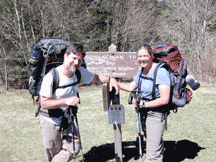
by Margaret Tearman
Who doesn’t dream of a long vacation? Wouldn’t you love to walk away from the stress and hectic pace of your daily life?
Yet would you — or could you — take a leave of absence from your job, lock up your house, stuff the bare necessities into a sack, hoist it onto your back and take off for a six-month walk in the woods?
That’s exactly what Edgewater residents Greg and Kathy Reshetiloff did. Last March, they set out from Springer Mountain, Georgia, to hike over 2,100 miles — about five million steps — to Mt. Katahdin, Maine.
Their route? The famed Appalachian Trail.
—No. 48: Nov. 30
Farewells
Joe Williams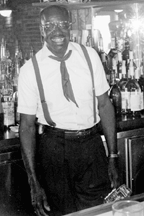
January 6, 1937 – January 10, 2006
Born in Harwood, Joe was a child of sharecroppers. Like so many people chasing the American dream, Joe wanted more from life, and as a young man he took a job in Galesville driving a truck for Woodfield’s Seafood. After two years he took another job at Pirates Cove.
“When I first came here,” Joe said, “I was a very scared kid.” He worked as a busboy for two weeks and then washed dishes for two weeks. “Then I came behind the bar one Sunday just to open beer. From that day on it’s been history.”
Behind the bar at Pirates Cove, Joe was in his element. Many a time someone would come up and say, “I was in here years ago, and I remember you.” Then Joe would smile, flashing those gold front teeth, and, more often than not, come up with the person’s name.
“There are no strangers,” Joe said, “just people I haven’t met yet.”
—J. Alex Knoll: No. 2: Jan. 12
Leonard Blackshear
June 29, 1943 – March 24, 2006
Leonard Blackshear worked miracles. How else to describe how a black man — and not even a Marylander — took a perpetual seat at Annapolis City Dock, companion to all who visit there?
As Martin Luther King had a dream, Leonard Blackshear had a vision. Reading Alex Haley’s Roots, which traces the Haley family history to an African prince sold into slavery at the Annapolis slave market at City Dock, Blackshear dreamed of transforming centuries of wrong in the heart of each person who visited that spot.
Alex Haley would sit there, in bronze, teaching both the bronze children who complete the statuary group and all the real visitors to come.
“Racism did not start in Annapolis,” Leonard said “But reconciliation did.”
He had vision with the persuasive energy to see it through.
—No. 14: April 6
Tom Abercrombie
August 13, 1930 – April 3, 2006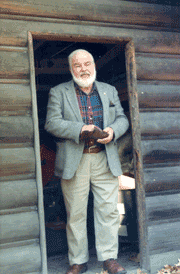
Like many in Chesapeake Country, we at Bay Weekly were deeply saddened by the passing this week of Tom Abercrombie, wise man, adventurer and world-class citizen.
Tom once told us that the most influential book in his life was his third-grade geography book back in Minnesota, and we came to understand why. Name a hot spot in the world, and Tom had been there, probably several times.
He had a 40-year career as a reporter/photographer for National Geographic, traveling to 80 countries before he retired in the mid-1990s. It was the era of rich and expansive journalism, before the bean-counters and graphics-mongers diminished the profession, and Tom would devote months to delivering stories from mysterious lands.
He was the first journalist to travel to the South Pole. Tom and his wife Lynn, a photographer and co-adventurer, were the first in the news business to be granted free rein in what is now southern Yemen, a Marxist state back then.
His death is a loss that will be felt far beyond Maryland. Seldom has such a gracious, learned and humorous person called our region home. Never have we known such a character.
With that impish grin and a witty remark or two, Tom would tell us we were nuts for writing such stuff. But anyone who knew him would agree.
—No. 14: April 6
Bill Marquess
July 24, 1923 – July 8, 2006
It was in my mind that I was gifted with music and that I was going to learn to play.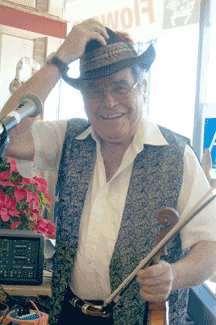
William Marquess was 11 years old when he got his first violin. It was ordered from a Sears catalog, delivered by truck to the little house in Chesapeake Beach where he lived with his widowed mother. The year was 1934. In that same little house, on the evening of July 8, 2006, Bill passed away from lung cancer.
We would listen to the Grand Ol’ Opry down there in Tennessee. There was Roy Acuff and the Smoky Mountain Boys … There were the Delmore Brothers. There were so many coming up at that time.
Some refer to the music from that era as roots music. Western swing, jazz, blues and country music are styles that grew from the roots. Bill was there, growing along with the music styles he loved to play.
His own roots were planted in local soil. He was just a boy when he became part of a trio that included his cousin and a friend. They played for tips at Chesapeake Beach Park. They played songs that they heard on the radio.
“I wanted to play that western swing music, and I got in with some guys who showed me, and I was able to do it.
He was a self-taught musician from the East Coast who went out west to play with some of the best musicians of the day. He succeeded in a competitive and demanding field. He was our local music icon. He was the roots, the trunk and all the branches of a musical tree that grew up here but spread to many places.
—Gary Pendleton: No 28: July 13
Bruce Bauer
April 15, 1931 – July 16, 2006
All of us in the Bay Weekly village mourn Bruce Bauer of Mason’s Beach. Retired Navy commander, destroyer and merchant captain and Bay elder, Bruce contributed his wisdom and stories beginning in the very early days of New Bay Times, as we were called from 1993 through 1999. He taught us about Fata Morgana, swans, hurricane shutters, shipwrecks and the peculiar history of a boat of his own, one of 186 Atalanta class sailboats made by Fairey Marine in the late years of World War II to be dropped from airplanes as lifeboats.
—No. 31: Aug. 3
Marion Warren
June 18, 1920 – September 8, 2006
Capturing life is the most vital thing photography can do. Documenting the real life of people, their real existence. No other art can do it.
—Bay Weekly Interview:
Vol. vi, No. 27: July 9, 1998
Marion Warren, the world-class photographer and Annapolitan known far and wide as Chesapeake Bay’s signature photographer, died Friday, September 8, 2006, at 86 years of age.
In seven decades of making pictures, Warren captured your life. He snuck up on fleeing time, seized it with a camera and printed it on film. Looking at the pictures he made, you understood why native people fear the camera as a thief of souls. Warren had your soul all right. Even if he never made your picture, your soul was there, printed in those big black-and-white photographs he made, looking back at you from the eyes of three boys, frozen in friendship and fun in 1940; reflected in the anticipation of five surf-bathers, stepping into the breaking waves on a summer day in 1958.
—Sandra Olivetti Martin: No. 37: Sept. 14
|








 drill; I have done this before.
drill; I have done this before.














